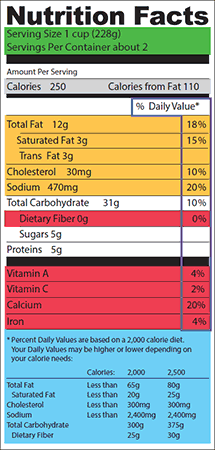The Nutrition Facts food label is changing to provide more detailed consumer information. Food products company must comply with the new label format by May 2018. Information in this topic is still accurate. To see more about the changes, see the link at the end of the text.
|

Sample, for illustration purposes only.
Source: U.S. Food & Drug Administration. |
Serving Size: Compare the serving size listed to the amount you actually eat. Remember that eating more (or less) than the serving-size amount means that you are getting more (or less) of the nutrients listed on the label. In this example, if you were to eat the entire container of food, you would actually be getting twice the amount of nutrients listed on the label.
Calories and Calories from Fat: We need food to live because it gives us energy, and we measure the amount of energy in foods in units called calories. There are three different kinds of nutrients that supply energy: carbohydrates, proteins, and fats. Each gram of carbohydrate or protein equals 4 calories of energy, and each gram of fat equals 9 calories of energy.
Although all calories give your body the same amount of energy, it is still important to pay attention to what nutrients they come from. In some foods (such as peanut butter, margarine, and oils), most of the calories come from fat. It is okay to eat these high-fat foods, but only in moderation. Over the course of the day, only 10% to 30% of your total calories should come from fat.
You can use the food label to find out if your diet falls in this range. To find out the percentage of calories from fat in your daily diet, follow these steps.
1. Add up the total number of calories you eat in a day (for example, 2000).
2. Add up the total number of calories from fat you eat in a day (for example, 500).
3. Divide the number of calories from fat by the total number of calories (500 ⁄ 2000=0.25).
4. Multiply your answer from step 3 by 100 (0.25×100=25%).
Remember, this number should be between 10% and 30%.
% Daily Value: For many of the nutrients listed on the food label (fat, carbohydrates, vitamins, and minerals), there is a recommended amount that people should eat each day.
Most of these nutrients are important parts of a healthy diet. Your body needs vitamins, minerals and carbohydrates—and even fat and sodium in moderation.
Getting enough vitamins, minerals, and dietary fiber (a healthy carbohydrate) may be difficult, but you should aim to get about 100% of the daily value.
For most people, getting enough fat and sodium is easy. In fact, many people get too much. Although your body does need fat and sodium, it does not need 100% of the daily value. That is why the food label recommends that you eat "less than" the amount of fat and sodium listed.
For saturated fat and cholesterol, the recommended amount is only an upper limit. You do not need them in your diet, so again, you should try to eat less than 100% of the daily value for saturated fat and cholesterol.
It is now a legal requirement for all food companies to list the amount of trans fat in a product if that food product contains more than 0.5 grams of trans fat in a single serving. So, food labels now list trans fat content on a separate line, under the saturated fat listing. Scientists do not know what a reasonable amount of trans fat is for a healthy diet, so food labels do not list a % daily value. Doctors and dieticians agree that you should keep the amount of trans fat in your diet as low as you can (zero if possible).
The recommended daily values are only estimates. The amount that people actually need varies according to the total number of calories they eat. As noted on the food label, the % daily values are for people who eat between 2000 to 2500 calories a day. People who need more calories may eat more fat and carbohydrates.
Learning More About Food Labels
View a Nutrition Facts label with brief descriptions of the main sections (PDF) published by the U.S. Food and Drug Administration.
See on other sites:
 U.S. Food and Drug Administration
U.S. Food and Drug Administration
Labeling & Nutrition: Consumer Information
www.fda.gov/Food/IngredientsPackagingLabeling/LabelingNutrition/ucm20026097.htm
Changes to the Nutrition Facts Label
www.fda.gov/Food/GuidanceRegulation/GuidanceDocumentsRegulatoryInformation/LabelingNutrition/ucm385663.htm
Updated August 2016



